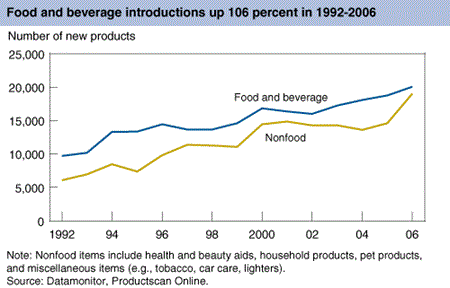Food Product Introductions Continue To Set Records

A record 20,031 food and beverage products were introduced in 2006, according to Datamonitor, a leading international supplier of information on new packaged products. Food categories with the largest share of new products included candy, gum, and snacks (28 percent), beverages (26 percent), condiments (9 percent), and dairy (7 percent). Ten years ago, beverages accounted for 19 percent of new food and beverage products, and condiments made up 18 percent.
Datamonitor typically classifies over 90 percent of new food and beverage product introductions as “not innovative.” Instead, these products may involve variations of existing products, such as new flavors, package sizes, or brand names. This practice suggests that food firms use new-product introductions as a differentiation strategy to present a fresh image to consumers, rather than providing truly novel products. In addition, failure rates for new products are exceptionally high, exceeding 90 percent for some categories.
From 2003 to 2006, “upscale” was the leading new product tag or claim, accounting for 9-13 percent of all new product claims, or 2,665 products in 2006. Datamonitor defines “upscale” as products such as premium ice cream, uniquely processed coffee, gourmet jam and dessert topping, and Certified Angus Beef. As incomes rise and consumers continually seek new experiences and tastes, the market for novel, luxury products grows.
“Natural” and “single serving” were the next two most common claims in 2006. “Organic,” “quick,” “fresh,” “low or no fat,” “no preservatives,” “kids,” and “high-vitamin” made up the remainder of the top 10 claims in 2006.
Cobranding has become an increasingly popular strategy for differentiating food products. Food processors typically pay a fee or royalty to place the logo of a popular food ingredient, container type, or media character—especially those that appeal to children—on a brand-name package. The logos represent a strong image that consumers easily recognize. In 2006, 279 cobranded products were introduced, compared with 16 in 1995. Recent examples include Breyers ice cream containing Splenda® brand sweetener and carrying Splenda’s logo, Hillshire Farm deli products packaged in Glad Ware® containers, and SpongeBob SquarePants™ characters on packages of Kraft Macaroni and Cheese.
The U.S. Food Marketing System: Recent Developments, 1997-2006, by Stephen Martinez, USDA, Economic Research Service, May 2007
Food Markets & Prices, by Hayden Stewart and Eliana Zeballos , USDA, Economic Research Service, March 2023


